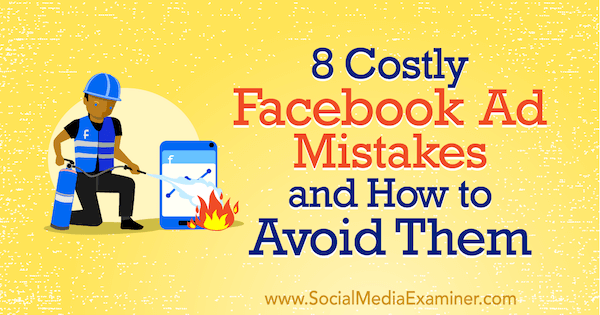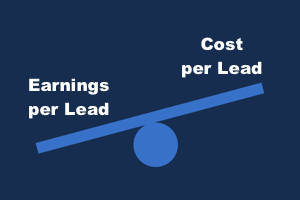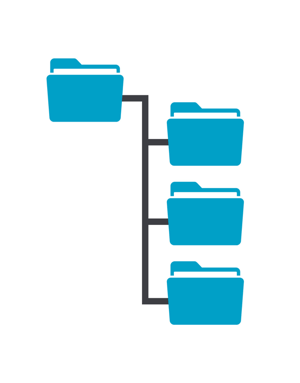 Are you making Facebook ad mistakes that could be eating away at your marketing budget? Are your ads helping Facebook more than they're helping your business?
Are you making Facebook ad mistakes that could be eating away at your marketing budget? Are your ads helping Facebook more than they're helping your business?
In this article, you'll discover the most common mistakes made with Facebook ads and how to resolve them from top Facebook advertising experts.

#1: Testing Multiple Interests in a Single Facebook Ad Set
 Ever had a Facebook ad that delivered amazing results for a few days, only to stop working soon after? Or created an ad that worked well without having any idea how to repeat that success?
Ever had a Facebook ad that delivered amazing results for a few days, only to stop working soon after? Or created an ad that worked well without having any idea how to repeat that success?
You usually encounter these types of issues when you bundle information in the creation process.
To visualize this, in the early stages of ads testing, many marketers who want to run Facebook ads to new audiences spend time researching relevant interests they can use to target. Then they run a set of ads with all of those interests in the same ad set.
Using interests is a great way to find new audiences, but this approach makes it impossible to discover which specific interest was most effective or to find additional interests similar to the interest that brought in the sale. And that makes the ad impossible to scale.
Instead, create a list of all of the interests you want to target and group the interests into several categories.

Then create multiple ad sets and target each one to a single group of interests. This way you'll know which audiences are best, how large each audience is, and how to find other interests to test.
Azriel Ratz has perfected a strategy to find ideal audiences and create the most relevant Facebook ads for businesses.
#2: Running Too Many Facebook Ads With Too Little Budget
 The one mistake I see more than any other are overly complex Facebook ad accounts: too many campaigns, too many ad sets, and too many ads. This leads to confusion, a lack of efficiency, high costs, and in the end, poor results. To illustrate, here are the 30-day stats from an ad account I recently audited:
The one mistake I see more than any other are overly complex Facebook ad accounts: too many campaigns, too many ad sets, and too many ads. This leads to confusion, a lack of efficiency, high costs, and in the end, poor results. To illustrate, here are the 30-day stats from an ad account I recently audited:
12 campaigns; 103 ad sets; 653 ads; $41,155.55 in ad spend; 6,247,351 impressions
This ad account was being managed by one person who was doing a good job but couldn't scale past a thousand dollars a day. How could one person possibly keep track of everything going on in 103 ad sets, let alone 653 ads?
If you have overly complex ad accounts, here's how to get them back on the right track:
Get World-Class Marketing Training — All Year Long!
Are you facing doubt, uncertainty, or overwhelm? The Social Media Marketing Society can help.
Each month, you’ll receive training from trusted marketing experts, covering everything from AI to organic social marketing. When you join, you’ll also get immediate access to:
- A library of 100+ marketing trainings
- A community of like-minded marketers
- Monthly online community meetups
- Relevant news and trends updates
Consolidate audiences into ad sets with larger budgets. This allows you to feed Facebook more data, get to the desired CPA quicker, and then scale up more rapidly. Combine the 1% lookalike of all buyers 365 audience and the lookalike of people who landed on your sales page in the last 30 days into one ad set in one combined audience—a super lookalike of sorts. In the same way, place all your digital marketing people, small business owners, and Facebook page Admin audiences into one combined ad set.

Pro Tip: Be sure to use Facebook's split testing tool for true A/B testing and Campaign Budget Optimization to figure out which ads and audiences work best.
Once you've consolidated your best audiences into just 2–3 ad sets, it's time to drop your best 3–6 ads in each ad set. Test new ad copy and creatives (both images and video) using true split testing in separate campaigns.
Facebook needs at least 50–100 conversions per ad set per week to fully leverage the algorithm, so your ad sets need a reasonable budget for the Facebook delivery system to power your ads. For a $5 lead, set your ad set budget at $35–$50/day (at a minimum). If you're using Campaign Budget Optimization with 3 ad sets, set your campaign budget at around $100–$150/day.
Ralph Burns is the founder and CEO of Tier 11, a digital advertising agency that specializes in helping businesses scale through Facebook and Instagram advertising.
#3: Focusing on Cost per Lead Over Earnings per Lead
 I see people making two major mistakes with Facebook advertising. The first is not testing the campaign elements organically before they roll out an advertising campaign. This covers everything from the micro element of an ad to the macro element of the sales process.
I see people making two major mistakes with Facebook advertising. The first is not testing the campaign elements organically before they roll out an advertising campaign. This covers everything from the micro element of an ad to the macro element of the sales process.
If an organic post on your Facebook page doesn't generate any clicks, shares, or sales, amplifying the post with an ad isn't likely to fix the problem. An ad will simply amplify what's already broken with your messaging and your sales process.
You're going to pay one of two ways to get the data you need to make decisions—data such as CTR, link click cost, conversion on landing page, sales conversion, earnings per lead, cost per lead, lifetime value of a customer, cost to acquire a customer, etc. You either pay to get that data (to find out where your stuff is broken) quickly through ads, or you pay with your time and organic posting so your ads work out of the gate.
 The second mistake is people focusing on the wrong number when they evaluate Facebook advertising. They focus on the cost per lead rather than earnings per lead.
The second mistake is people focusing on the wrong number when they evaluate Facebook advertising. They focus on the cost per lead rather than earnings per lead.
Cost per lead is a finite number that can only be reduced to a certain point and it is subjective to your earnings per lead. Earnings per lead is how much you earn for every person who comes through your sales process.
For example, if an ad is delivering multiple $100 sales at a $4 cost per lead, people may want to shut off the highly profitable ad in favor of an ad that isn't as profitable in order to reach a $2 cost per lead.
If your earnings per lead is $100 and your cost per lead is $4, that's 25x your investment and it's a great return on your ad spend.
Amanda Bond is owner of The Ad Strategist and the creator of The StrADegy System.
#4: Selecting the Wrong Facebook Campaign Objective
 The first mistake I see is people using Facebook ads to sell too quickly. They create an ad that pushes cold audiences directly to a sales page to sell something right off the bat.
The first mistake I see is people using Facebook ads to sell too quickly. They create an ad that pushes cold audiences directly to a sales page to sell something right off the bat.
It's too fast and completely inappropriate, and it violates one of the golden rules of social media advertising: You must give before you ask.
You need an intermediary step for lead generation in which you provide something of value in advance. This is the start to a conversation you can use to build a relationship you can nurture. Then when people are ready to buy, they're more likely to do so from you.

Discover Proven Marketing Strategies and Tips
Want to go even deeper with your marketing? Check out the Social Media Marketing Podcast! Publishing weekly since 2012, the Social Media Marketing Podcast helps you navigate the constantly changing marketing jungle, with expert interviews from marketing pros.
But don’t let the name fool you. This show is about a lot more than just social media marketing. With over 600 episodes and millions of downloads each year, this show has been a trusted source for marketers for well over a decade.
This leads to the second mistake, which is selecting the wrong objective in the campaign structure. Many people looking for leads will select lead ads, engagement, or clicks when they should be selecting conversions and optimizing for leads.
Ninety percent of the time, this selection will result in stronger performance.
Nicholas Kusmich, a leading Facebook advertising strategist and international speaker, is founder of the H2H Media Group and the Marketers Council.
#5: Running Facebook Ads With Zero Follow-up Management
 The biggest mistake I see advertisers make on Facebook is not managing campaigns after they're active. Set up a campaign and let it run on its own, and it will decrease in effectiveness over time due to Facebook ad fatigue.
The biggest mistake I see advertisers make on Facebook is not managing campaigns after they're active. Set up a campaign and let it run on its own, and it will decrease in effectiveness over time due to Facebook ad fatigue.
The key to developing sustainable results from Facebook advertising is to analyze your campaigns on an on-going basis. Look at your Return on Ad Spend and the cost, relevance, frequency, and CPM metrics and then make adjustments to ad creative and copy, as well as objective and targeting.
Charlie Lawrance is founder and CEO of Gecko Squared, a digital marketing agency that specializes in Facebook advertising.
#6: Creating New Facebook Ads Rather Than Managing Successful Ads
 Ninety-five percent of the time I audit a Facebook ad account, there are way too many ad sets. Facebook's optimization algorithm needs at least 50 conversions per ad set per week to function. So if you have a dozen ad sets or campaigns each with just a few conversions, you're squandering your audience and not allowing the system to optimize.
Ninety-five percent of the time I audit a Facebook ad account, there are way too many ad sets. Facebook's optimization algorithm needs at least 50 conversions per ad set per week to function. So if you have a dozen ad sets or campaigns each with just a few conversions, you're squandering your audience and not allowing the system to optimize.
 In accounts spending less than $10,000 a month, 3 campaigns with 3 ad sets are usually more than enough, because the custom audiences, lookalikes, and saved audiences are big enough for CPM to do its job. Accounts spending more than $100,000 a month have enough traffic to drive 50+ of each type of conversion objective across a few dozen ad sets. Yet, most of the accounts spending over a million dollars a year drive sales through just 2–3 winning ad sets—not hundreds.
In accounts spending less than $10,000 a month, 3 campaigns with 3 ad sets are usually more than enough, because the custom audiences, lookalikes, and saved audiences are big enough for CPM to do its job. Accounts spending more than $100,000 a month have enough traffic to drive 50+ of each type of conversion objective across a few dozen ad sets. Yet, most of the accounts spending over a million dollars a year drive sales through just 2–3 winning ad sets—not hundreds.
Related to creating too many campaigns is not continuing to put more money into your “greatest hits” ads. Many Facebook advertisers have the publisher mindset, where they feel the need to create a steady stream of content—X posts per day and Y ads per day. But you're not a newspaper that has to have fresh news to report each day.
Instead of spawning more campaigns, put more money into your proven winners. We have campaigns where winning ads have been running for years. Rather than putting $50 on each new campaign, go back to analyze and adjust winners before they die.
Remarketing is so effective, that even done poorly, it often yields fantastic results. But if you're remarketing to 1-, 7-, and 28-day audiences with the same creative, you're saying the same thing over and over. You might as well have this in one ad set, so the system can optimize to the lowest cost per conversion and benefit from 50+ conversions per week in each ad set; change up that creative and say something specifically relevant to the users in that bucket.
Dennis Yu is the chief technology officer of BlitzMetrics and an internationally recognized lecturer in Facebook marketing.
#7: Creating Facebook Ads Without Understanding Overall Campaign Settings
 One of the biggest mistakes I see business owners make is running ads without understanding the implications of the settings they choose in Facebook Ads Manager, or even when boosting posts. The wrong settings or selections can waste money on bad ad placement, bad optimization, or bad targeting.
One of the biggest mistakes I see business owners make is running ads without understanding the implications of the settings they choose in Facebook Ads Manager, or even when boosting posts. The wrong settings or selections can waste money on bad ad placement, bad optimization, or bad targeting.
Many business owners don't understand that opting for Automatic Placements will place their ads not only on Facebook but also on Instagram and across the Audience Network (sites off of Facebook).
Others optimize for Lead Generation (which happens via a form on Facebook) when they really want Conversion (which happens on their website), or they select Brand Awareness when Traffic is what they're after.

Targeting decisions, made at the Ad Set level, may be too wide or too narrow for the available budget.
Facebook ads work for a wide variety of businesses. Successful results are typically a matter of doing the right testing and proper ad setup.
If you aren't familiar with Facebook ad set-up settings, investing in training for yourself or someone on your team will help stop you from wasting money or concluding that Facebook ads don't work.
Andrea Vahl, co-author of Facebook Marketing All-in-One For Dummies, is a social media coach, speaker, and strategist.
#8: Over-Reliance on Automatic Placement for Facebook Ads
 Selecting Automatic Placement for your Facebook ads is easy, can speed up the creation of your ads, and can stop you from selecting the wrong placements for your ads; for instance, choosing video placements when you have no video in your ad.
Selecting Automatic Placement for your Facebook ads is easy, can speed up the creation of your ads, and can stop you from selecting the wrong placements for your ads; for instance, choosing video placements when you have no video in your ad.
That said, the placement of your ad directly influences the cost and performance of your ad sets and campaigns.
To illustrate, Facebook's Audience Network placement (often the cheapest of placements) can be great for reach, but it will also eat through your budget if you're not careful. How? If your Audience Network placement is performing well and reaching high numbers of people, Facebook will automatically push more budget into that placement because it's cheap.

In this way, Audience Network placements can chomp through your money without offering much reward.
At the other extreme, Instagram placements tend to be pricier, but if your audience is on Instagram and you can connect with them via those ads, your spend on the platform can be worth it.
The key to making sure your placements aren't wasting your spend is to think carefully about what you want from your ad and which placement will give you that result. Think about the strategy behind your ads before you accept the defaults.
Pro Tip: Facebook ad placements can be edited. If you deselect Audience Network because you want more of a controlled spend but find that your budget is underspending, you can always enable Automatic Placement again.
Amy Hayward is a certified Facebook Blueprint Buying Professional and the resident social media expert at Meticulosity.
What do you think? What mistakes do you see Facebook marketers making? Please share your thoughts in the comments below.
More articles on Facebook advertising:
- Find five Facebook ad mistakes that could be hurting you.
- Learn how to use Facebook ad sequences.
- Discover how to get leads with Facebook Messenger ads.
Attention Agency Owners, Brand Marketers, and Consultants

Introducing the Marketing Agency Show–our newest podcast designed to explore the struggles of agency marketers.
Join show host and agency owner, Brooke Sellas, as she interviews agency marketers and digs deep into their biggest challenges. Explore topics like navigating rough economic times, leveraging AI, service diversification, client acquisition, and much more.
Just pull up your favorite podcast app, search for Marketing Agency Show and start listening. Or click the button below for more information.

